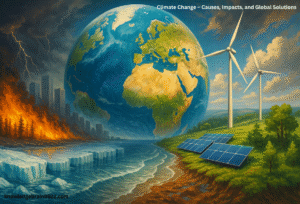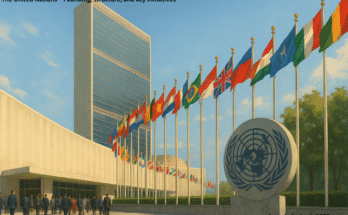
The causes, effects, and international Solutions of Climate Change Overview The effects that will last for a long time of the changes to the regular patterns of climate change typically resulted from human activities in those years following the Industrial Revolution are referred to as changes in the climate. Global warming and its impacts on ecosystems and economy, as well as communities are caused by the trapping of high temperatures within the atmosphere as a result of the growing volume of greenhouse gases. The reasons for global warming and the enormous implications, and the worldwide alternatives to reduce and limit these effects, will be explored in this article. The effects.
- Climate Change Causes
1.1 It is the greenhouse emission of gases
About 76% of the global warming triggered by humans comes via CO2 (CO2) and CO2 is the main reason. The most relevant sources include:
Making use of coal, oil along with natural gas for energy production transport, heat and energy is known as fossil combustion. the fuels.
The elimination of forests to construct or in agriculture, release carbon in soil, which trees take in.
Industrial Methods: The production of steel and cement production. certain chemical reactions create carbon dioxide.
A little over 16% of humans’ greenhouse gases come from methane (CH4). The main sources include:
Agriculture: cattle enteric fermentation, rice paddies.
These fossil fuels include natural gas extracting coal from mines and the leakage of pipelines.
Waste Management Waste management as well as landfills and waterways.
About 60% of the total comes from the nitrogenus oxide (N2O). It is released by:
Use of Fertilizers The agriculture industry makes use of the nitrogen-based chemical fertilizers.
Manure Management: reducing the quantity of manure that is created by animals.
Nitric acid production as well as the manufacture of adipic acid are two instances of industrial processes.
The powerful heat-trapping gases that are utilized in industrial and refrigerant contexts are called fluorinated gas (CFCs HFCs, CFCs and SF6). Although they’re not as prevalent, but they’re highly hazardous and could have the possibility of contributing to the global warming.
1.2 Deforestation of the Land Use Change: Palm oil as well as cattle ranching can all result in the deforestation of tropical forests in Southeast Asia, the Amazon along with Congo Basin. Congo Basin.
Urbanization: The procedure of building cities and infrastructure enhances the ability to retain energy (urban heat islands) and also reduces greenhouse gas emissions.
Expanding Agriculture: Changes in local climate regulation as a result of depletion of carbon from soils due to the intensive cultivation.
1.3 Energy Production and Industrialization
Reliance on fossil energy sources: Coal gas and oil continue to be the major source of more than 90% of the energy consumed around this world.
Emission-intensive industries The chemical industry, steel and textiles as well as cement are all accountable for large amounts of greenhouse gas emissions.
Transportation Petroleum is an essential component in the making of trucks and cars, along with planes and ships. Transportation Petroleum accounts for about 14 percent of carbon dioxide emissions worldwide.
1.4 The pattern of landfills and waste consumption: Methane is released in the course of anaerobic digestion for organic waste.
consumerism. The growing consumption of goods by consumers fuels the mining of resources and causes pollution to manufacturing.
Food Wastage: A third of all food items are discarded, causing waste of carbon and water.
- Climate Change’s Effects
2.1 Effects on the Environment and Body
Temperature Increase: Since around the turn of the century, temperatures on Earth have risen by about 1.1degC. The intensity and intensity of heat waves are growing.
Melting Ice glaciers Sea-level rise is an outcome of the shrinking mountain glacier aswell being the demise of Greenland and Antarctic glaciers as well in the thinning of Arctic sea Ice.
Sea-level rise as the result of temperature rise and the melting of ice average sea level has increased about 20 centimeters over the past 100 years, which is in danger of small islands as well as coastal low-lying areas.
Ocean acidification: Around 30% of CO2 emissions get absorbed by the oceans. They lower pH levels and place the coral reefs, shellfish as well as other marine species in danger.
Droughts, hurricanes and typhoons extreme rainfall, as well as storms that result in extreme floods or land slides. Also, wildfires are all instances from extreme weather.
2.2 Effects on Biodiversity and the Environment
Habitat changes Animals must move into higher elevations or more temperate temperatures. The reason for this decline can be traced to the difficulty of many of species to adapt to climate change quickly enough.
Coral bleaching Extensive deaths in coral reefs caused by the stressing of coral polyps as a result of the warmer temperatures of the ocean may create ripples in ocean ecosystems.
Disordered Phenology: The differences in flowering, migration, and breeding timings affect interactions among different species (e.g. pollinators, the plants ).
A species of invasiveness: Our native biodiversity is at risk from invader insects and diseases which thrive in warmer climates.
2.3 Effects on Human Health and Socioeconomic Status
Food security in tropical and subtropical zones, the yields of essential elements like rice, wheat and maize could drop, and pests and diseases are predicted to spread.
Water Scarcity The shifts in the patterns of rain put stress on the availability of water and cause water shortages in certain regions as well as flooding in other regions.
Health hazards Health risks: The increased frequency of respiratory problems as a result of wildfires, polluted air. Additionally, vector-borne infections like malaria and dengue along with heat-related ailments.
Economics Costs Every year, the damage caused by extreme weather events can amount to millions of dollars. The economy is squeezed by the loss of production and communities having to relocate in addition to the maintenance of infrastructure.
human displacement. Tens to millions of people are likely to be relocated by the end of the century due to resource scarcity and increasing sea levels that could result in a rise in the conflict between geopolitical and social classes.
- Worldwide Remedies: Adaptation and Mitigation
3.1 Strategies for Mitigation
The aim of mitigation is to increase the effectiveness of carbon sinks as in reducing greenhouse gases emissions.
3.1.1 Transformation of Energy
Renewable energy: More the use of hydroelectric, geothermal and wind and solar energy. Renewables are becoming cost-effective because of decreasing costs.
Energie Efficiency Increase industrial processes, put in place efficiency-based equipment and retrofit homes with insulation, as well as help to support the transportation system for public use.
Electricity: Change from the use of fossil fuels for heating and transportation system to renewable energy-powered electric energy system.
3.1.2 Management of Carbon
Reforestation and Afforestation Carbon is taken up by the forest regeneration in destroyed areas, as well as the creation of the new forest.
Pricing of carbon: To encourage emissions reductions, it is possible to introduce carbon taxation, or cap and trade programs.
Carbon Capture and Storage (CCS): Capture CO2 produced by industrial and power infrastructure, and then store it underground or utilize to make things.
3.1.3 Sustainable agroforestry as well as sustainable land use The trees are cultivated on land used for agriculture to increase soil fertility as well as absorb carbon.
Regenerative agriculture – methods to improve soil carbon, as well as resilient are rotational grazing. It is a method of covering crops using the principle of less labor.
Changes to your food habits: Lower the consumption of dairy products and meat, particularly those from animals with Emission levels that are excessive and also reduce the quantity of food that is wasted.
3.1.4 Innovation in Industry
Green Manufacturing Utilize the circular economy principles which include cutting down on waste and recycle and reuse.
Low Carbon Materials: Provide alternative to steel and cement, such as advanced composites, as well as concrete that is green.
Process optimization refers to changing refrigerants from high-GWP to low-GWP and also capture fugitive methane that escapes gasoline and oil.
3.2 Strategies for Adaptation
It decreases the vulnerability to environmental impacts.
3.2.1 Resilience of Infrastructure
Flood protections: To reduce flooding from occurring and storm surges, construct coastal walls and levees and wetland that has been rehabilitated.
designed for climate resilience Create sustainable solar structures that have green roofs, eco sustainable buildings and construction material that is heat-resistant.
Wasser Management Whenever required, install a reliable irrigation system. rain collection, and desalination system.
3.2.2 Disaster Preparedness and Early Warning Systems
Monitoring Networks Expand the number of sensors used for hydrology and meteorology to allow the collection of data at a constant speed.
Be sure that the community is ready by preparing evacuation plans, shelters and community education programs.
Ecosystem-Based adaptation: Restore and save forests and mangroves and coral reefs that provide organic barriers to destruction and hurricanes.
3.2.3 Urban Planning That Is Sustainable
Green Spaces To reduce the effect on heat island, construct additional green spaces and forests.
Transit-Oriented Development to reduce pollutant emissions and to improve the quality of air. Make sure that walkable areas are prioritized and there is transportation that is available to everyone.
Water-sensitive Design In order to control the runoff of an area, you may utilize permeable roads, wetlands, and bioswales and the creation of artificial rivers.
3.2.4 Health and Social Protection Infrastructure for Public Health in order to prevent diseases triggered to climate change. amount of health clinics as well as hospitals.
Social Security Nets Provide cash assistance to aid community members rebuild and migrate to communities that are in danger.
Capacity building and training inform communities on the best ways to handle emergencies and about climate-wise techniques.
- Global Structures and Collaboration
4.1 The Accord in Paris
The Paris Agreement, which was adopted in 2015, is component of UN Framework Convention on Climate Change (UNFCCC) Its goal is to stop the increase of temperatures in the world below 2 ° Celsius from the preindustrial level. The agreement also sets a goal of 1.5degC as the target. Its key characteristics are:
Nationally Determined Contributions (NDCs) The targets for reducing emissions are suggested for review by countries.
International Stocktakes Parties review their progress collectively each five years.
Climate finance: Every year, nations of the industrialized world commit 100 billion dollars to help those from developing nations in adapting and lessening.
Framework that ensures Transparency Continuously monitoring the latest developments, emissions and other aid in the pursuit of the accountability of those who use it.
4.2 Additional Multilateral Projects
The Green Climate Fund (GCF) provides funding for climate-friendly projects that are low emissions that are in vulnerable countries.
Reducing emissions due to Deforestation, in addition to Forest Degradation, or REDD+, assists in the storage of carbon to help promote the preservation for forests.
Mission Innovation is an internationally-based initiative that utilizes public-private partnerships that aim to help accelerate the development of new energy technologies that can be sustainable.
4.3 Non-State Actors’ Function
Cities and Regions: Part of the C40 network, more than 1,000 cities from around the world have pledged to meet their targets of carbon neutrality.
Businesses: A lot of Fortune 500 firms invest in environmentally friendly technology. They also set science-based goals which align with 1.5degC pathways.
Civil Society Religious organisations as well as NGOs and community organizations that oversee the conduct of business by their members, give public backing and take on initiatives to stop the practice.
- Personal and Group Initiatives
5.1 Lifestyle Decisions
Home You can increase the efficiency of your home’s energy by removing all electronic devices from your home after which you can insulate and convert the LEDs into light bulbs.
Public transport, including walking, biking in carpools, changing in electric vehicles are all instances of sustainable transportation that are environmentally friendly.
Locally produced goods Consume a lot of plant-based products in addition to reducing food waste.
5.2 Local Advocacy and Engagement: Encourage green building standards and better public transportation that is efficient and laws on green energy.
The Grassroots Initiative Start community recycling programs along with trees-planting events and community gardens.
Education: Enhance awareness of the climate change solutions by using the social media channels, both at work and in educational institutions.
To conclude
Although climate change has the potential for a major threat to humankind, it also provides the potential for previously unimagined human cooperation as well as imagination. The need for rapid mitigation due to the fact that it is a root cause of forest destruction carbon dioxide emissions, as well the unsustainable use of resources. The consequences that can are ranging from catastrophic events in the weather, as well as economic disturbances highlight the need to cut emissions as well as increase the capacity of. The shifts that are occurring in the industry, land use and energy systems to a low carbon model, and the adaptation of structures, ecosystems, and societies to shifts that are currently occurring are the two main elements that make up the overall framework. Frameworks are created via international agreements, like those in the Paris Agreement, but individual options, corporate accountability and plans at a national level in addition to Indigenous sustainability are crucial to success in implementation. Even though the way ahead might be difficult however, we can save the planet’s climate and ensure the long-term sustainability of the future generation if we collaborate and come up with innovative ideas.



